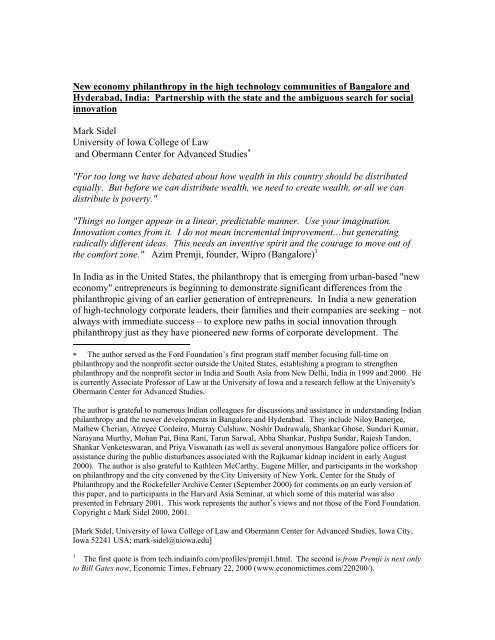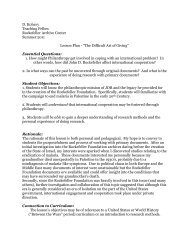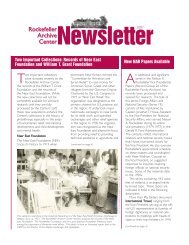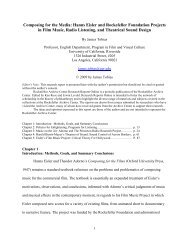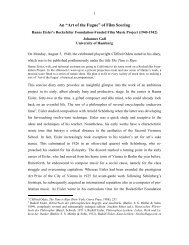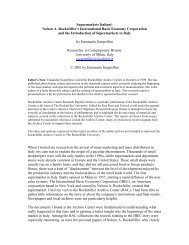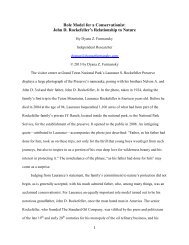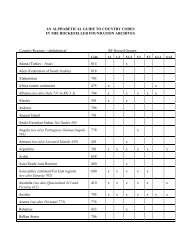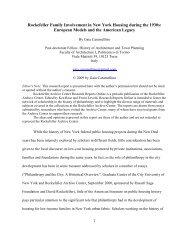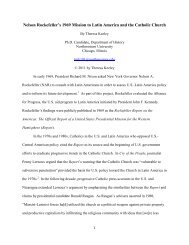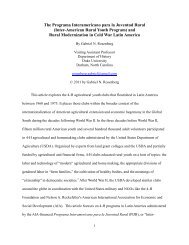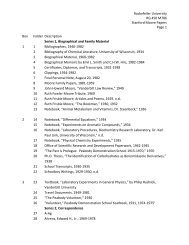Mark Sidel - The Rockefeller Archive Center
Mark Sidel - The Rockefeller Archive Center
Mark Sidel - The Rockefeller Archive Center
Create successful ePaper yourself
Turn your PDF publications into a flip-book with our unique Google optimized e-Paper software.
New economy philanthropy in the high technology communities of Bangalore and<br />
Hyderabad, India: Partnership with the state and the ambiguous search for social<br />
innovation<br />
<strong>Mark</strong> <strong>Sidel</strong><br />
University of Iowa College of Law<br />
and Obermann <strong>Center</strong> for Advanced Studies ∗<br />
"For too long we have debated about how wealth in this country should be distributed<br />
equally. But before we can distribute wealth, we need to create wealth, or all we can<br />
distribute is poverty."<br />
"Things no longer appear in a linear, predictable manner. Use your imagination.<br />
Innovation comes from it. I do not mean incremental improvement…but generating<br />
radically different ideas. This needs an inventive spirit and the courage to move out of<br />
the comfort zone." Azim Premji, founder, Wipro (Bangalore) 1<br />
In India as in the United States, the philanthropy that is emerging from urban-based "new<br />
economy" entrepreneurs is beginning to demonstrate significant differences from the<br />
philanthropic giving of an earlier generation of entrepreneurs. In India a new generation<br />
of high-technology corporate leaders, their families and their companies are seeking – not<br />
always with immediate success – to explore new paths in social innovation through<br />
philanthropy just as they have pioneered new forms of corporate development. <strong>The</strong><br />
∗ <strong>The</strong> author served as the Ford Foundation’s first program staff member focusing full-time on<br />
philanthropy and the nonprofit sector outside the United States, establishing a program to strengthen<br />
philanthropy and the nonprofit sector in India and South Asia from New Delhi, India in 1999 and 2000. He<br />
is currently Associate Professor of Law at the University of Iowa and a research fellow at the University's<br />
Obermann <strong>Center</strong> for Advanced Studies.<br />
<strong>The</strong> author is grateful to numerous Indian colleagues for discussions and assistance in understanding Indian<br />
philanthropy and the newer developments in Bangalore and Hyderabad. <strong>The</strong>y include Niloy Banerjee,<br />
Mathew Cherian, Atreyee Cordeiro, Murray Culshaw, Noshir Dadrawala, Shankar Ghose, Sundari Kumar,<br />
Narayana Murthy, Mohan Pai, Bina Rani, Tarun Sarwal, Abha Shankar, Pushpa Sundar, Rajesh Tandon,<br />
Shankar Venketeswaran, and Priya Viswanath (as well as several anonymous Bangalore police officers for<br />
assistance during the public disturbances associated with the Rajkumar kidnap incident in early August<br />
2000). <strong>The</strong> author is also grateful to Kathleen McCarthy, Eugene Miller, and participants in the workshop<br />
on philanthropy and the city convened by the City University of New York, <strong>Center</strong> for the Study of<br />
Philanthropy and the <strong>Rockefeller</strong> <strong>Archive</strong> <strong>Center</strong> (September 2000) for comments on an early version of<br />
this paper, and to participants in the Harvard Asia Seminar, at which some of this material was also<br />
presented in February 2001. This work represents the author’s views and not those of the Ford Foundation.<br />
Copyright c <strong>Mark</strong> <strong>Sidel</strong> 2000, 2001.<br />
[<strong>Mark</strong> <strong>Sidel</strong>, University of Iowa College of Law and Obermann <strong>Center</strong> for Advanced Studies, Iowa City,<br />
Iowa 52241 USA; mark-sidel@uiowa.edu]<br />
1<br />
<strong>The</strong> first quote is from tech.indiainfo.com/profiles/premji1.html. <strong>The</strong> second is from Premji is next only<br />
to Bill Gates now, Economic Times, February 22, 2000 (www.economictimes.com/220200/).
activities of these Indian new economy philanthropists are just emerging, and one<br />
purpose of this paper is to provide information and analysis on their activities.<br />
It is already clear, however that in the choices of philanthropic goals, targets, forms and<br />
partnerships, the road to social innovation for these new Indian entrepreneurs will be<br />
even rockier than the path to economic innovation has been, and that the overlapping<br />
burdens and goals of their philanthropic endeavors will require both clear thought and<br />
some sorting out in the years ahead. This paper also seeks to analyze the choices and<br />
challenges these new Indian philanthropists face.<br />
When we consider philanthropy in India, we usually think of older traditions – charitable<br />
giving for the poor, destitute and sick; religious giving at Hindu temples and to Hindu<br />
religious and cultural groups; zakat and other forms of Muslim giving in the large Indian<br />
Islamic community if we think beyond the Hindu context. 2 In the twentieth century,<br />
these traditional modes of giving were supplemented by newer styles of philanthropy,<br />
usually based in the wealthy, urban manufacturing and financial houses of Bombay<br />
(Mumbai)-based elite families such as the Tatas and the Birlas. This newer, often more<br />
secular, and often more institutionally focused philanthropy also emphasized traditional<br />
needs such as schooling and health care. But several elements were new: an emphasis<br />
on institution-building, a willingness to support institutions of higher education, nongovernment<br />
organizations and other kinds of civil society institutions as development<br />
intermediaries, a willingness to work well beyond the state, and an emphasis on corporate<br />
responsibility, in addition to personal and family philanthropy. 3<br />
In their willingness to grow endowment assets, to deploy some of those assets through<br />
family foundations, to build institutions, to work with intermediary and recipient NGOs,<br />
and to recognize the role of the corporation in social good, the modern sensibilities of<br />
Tata and other philanthropy has presaged the forms and choices that face and challeng<br />
India's "new economy" philanthropists. But the "new economy" philanthropists are also<br />
challenged and benefitted by other, more recent developments in Indian philanthropy as<br />
2<br />
For useful reviews of the state of Indian philanthropy from a variety of perspectives, see among other<br />
works Charities Aid Foundation/India (ed.), An introduction to the nonprofit sector in India (Charities Aid<br />
Foundation, 2001, forthcoming); Noshir Dadrawala, Management of philanthropic organisations (Centre<br />
for Advancement of Philanthropy, 1996); R. M. Lala, <strong>The</strong> heartbeat of a trust: <strong>The</strong> story of the Sir Dorabji<br />
Tata Trust (revised 3d ed., Tata McGraw Hill, 1998); Pushpa Sundar, Directory of Indian donor<br />
organisations (Indian Centre for Philanthropy, 1999); Pushpa Sundar, Beyond business: From merchant<br />
charity to corporate citizenship, Indian business philanthropy through the ages (Tata McGraw Hill, 1999);<br />
South Asia Fund Raising Group, A guide to resource mobilisation for voluntary organisations in India<br />
(New Delhi, 2000).<br />
3<br />
<strong>The</strong> Sir Ratan Tata Trust and the Sir Dorabji Tata Trust are the most prominent of the family<br />
foundations to have emerged in India, though there are many others also affiliated with prominent Indian<br />
business families. <strong>The</strong> Sir Dorabji Tata Trust is the subject of R. M. Lala, <strong>The</strong> heartbeat of a trust: <strong>The</strong><br />
story of the Sir Dorabji Tata Trust (revised 3d ed., Tata McGraw Hill, 1998). Both these trusts and other<br />
Tata giving vehicles are described in summary form at www.tata.com/0_beyond_business/trusts/. A<br />
superb discussion and analysis of these twentieth century innovations in philanthropy is Pushpa Sundar,<br />
Beyond business: From merchant charity to corporate citizenship, Indian business philanthropy through<br />
the ages (Tata McGraw Hill, 1999).<br />
2
well. In recent years, for example, tightly controlled family foundations and corporate<br />
giving have itself been supplemented by national, non-family, private foundations with<br />
independent boards that have chosen to work on a broader array of topics – poverty<br />
alleviation, the rights of minorities and women, arts and culture among them. 4 And a<br />
nascent discussion of community foundations and community funds in India promises<br />
further to enrich the mix of options available for philanthropy, for the "new economy"<br />
wealthy, and for many other givers in India. 5<br />
In the past several years, however, newly wealthy Indian entrepreneurs based in the "new<br />
economy" of information technology, biotechnology and other fields and centered in<br />
Bangalore and Hyderabad have begun to develop their own modes of philanthropic<br />
giving. In doing so they have challenged some of the precepts of earlier urban-based<br />
Indian philanthropy. In particular, their early grantmaking has, explicitly or implicitly,<br />
challenged the emphasis that the Tatas and others placed on institution-building, their<br />
emphasis on working with non-governmental organizations as development<br />
intermediaries, and their frequent willingness to eschew the state in the private<br />
philanthropic and development process.<br />
In Bangalore and Hyderabad, which along with Bombay are key cities of the Indian new<br />
economy, large information technology companies such as Infosys and Wipro lead both<br />
in corporate growth and in new forms of giving that are emerging from the rapid creation<br />
of wealth in a relatively few hands. <strong>The</strong>se sectors are the most rapidly growing parts of<br />
the Indian economy, and they are generating significant wealth for managers and<br />
professionals, both in terms of stock options and in cash compensation.<br />
Some of this new institutional and individual wealth is, in turn, being channelled to<br />
public purposes as philanthropy – but a philanthropy that directly challenges both the<br />
giving and the receiving of the past. <strong>The</strong> giving that is emerging from these newly<br />
wealthy and the new middle class is diverse, it is focused, it is often allied with state<br />
interests, it is often anti-institutional and anti-intermediary – and it is growing with<br />
exceptional speed.<br />
<strong>The</strong> new economy philanthropy of Bangalore and Hyderabad is also influenced by and<br />
encouraging heavy inflows of diasporic giving by Indians based abroad, often from high<br />
technology centers of the San Jose valley and other American “new economy” centers.<br />
Tracking those diaspora gifts in detail is exceptionally difficult, but the main priorities of<br />
4<br />
<strong>The</strong> most prominent of India’s private national foundations are the National Foundation for India<br />
(webpage nfidel.tripod.com), which funds in a range of areas, and the India Foundation for the Arts<br />
(profiled briefly at www.cafonline.org/cafindia/ on the NGO page), which focuses on support for arts and<br />
culture. An analogue in Bangladesh is the Bangladesh Freedom Foundation, www.aurorabd.com/bff/.<br />
5<br />
Community foundations are under discussion in Ahmedabad, Bangalore, Delhi and elsewhere, in some<br />
cases with small grants from the Ford Foundation. India's sole existing community foundation is the<br />
Bombay Community Public Trust, founded in 199x. For a useful review and analysis of the BCPT's first<br />
years, see Pushpa Sundar (ed.), xxx. A community fund on the United Way model is being built in<br />
Bombay (Mumbai) as well, with support from United Way International.<br />
3
that giving include higher education and training in science and technology. Giving for<br />
those purposes has, at least according to the interview and anecdotal data available,<br />
rapidly dwarfed most other Indian diaspora giving into the high technology centers of<br />
Bangalore and Hyderabad and into other Indian regions as well. 6<br />
<strong>The</strong> new Indian philanthropy seeks, at least in rhetorical terms, to be as socially<br />
innovative as its underlying corporate foundations have been innovative in the economic<br />
and technological arenas. But at least in its early years this new philanthropy is finding it<br />
more difficult to locate and pursue approaches to social innovation than it did in its core<br />
businesses. And the pro-state, anti-intermediary and anti-institutional focus of the new<br />
Indian philanthropists is under pressure as philanthropic donations increase and ways<br />
need to be found to evaluate and track grantmaking.<br />
Beyond India’s Gateses and India’s Microsofts: <strong>The</strong> emerging diversity of the new<br />
Indian philanthropic givers<br />
In the brief time in which philanthropy has begun to flourish in the Indian "new<br />
economy" cities of Bangalore and Hyderabad, attention has already focused on several<br />
large companies (information technology giants Infosys and Wipro among them) and on<br />
their wealthy founders (Narayana Murthy and Azim Premji). But while, in different<br />
ways, Infosys, Wipro, Murthy and Premji are very important to the development of new<br />
philanthropy in the Indian new economy, the picture is considerably more diverse than<br />
those companies, individuals and their families.<br />
Instead, in research and interviews in India, a considerably more diverse and<br />
differentiated picture has begun to emerge. In Bangalore and Hyderabad expanding<br />
charitable and philanthropic giving is channeled through individual gifts ranging from<br />
small to very large amounts, self-generated collections of donations and volunteer time<br />
by corporate employees organized on a horizontal basis (which I call here "giving<br />
circles," though that is not a term used in India), corporate giving and volunteer<br />
programs, corporate foundations, family foundations, slowly emerging payroll giving,<br />
and in other ways. And, of course, more traditional giving patterns persist as well:<br />
extensive charitable and relief giving, active Rotary, Lions, and other service<br />
organizations, 7 and very active religious charity and philanthropic work, among Hindu,<br />
Christian and other communities. 8<br />
Understanding the diverse channels of the new giving in the Indian new economy is<br />
particularly important because our attention – and the attention of Indian civil society<br />
6<br />
For the best study thus far of the Indian diasporic experience in philanthropic giving, see Priya<br />
Viswanath, [Indian diaspora giving from the U.S.] (Charities Aid Foundation, New Delhi, 2000).<br />
7<br />
On the activities of the service clubs in Bangalore, see for example www.rotaryclubofbangalore.org,<br />
www.welcome.to/lionsclub; for Rotary and Lions activities in Hyderabad, see www.andhratoday.com/rchn/<br />
and www.hydsouthlions.org. <strong>The</strong> Masons and other groups are also active in south India.<br />
8<br />
For a review of forms, methods and goals in Indian religious giving, see xxx.<br />
4
organizations – can easily be drawn aware by the good work of a few large institutions<br />
and wealthy individuals. But it is a serious mistake to reduce the “new Indian<br />
philanthropy” to the work of certain individuals or certain companies, for that loses a<br />
forest of useful giving for a few tall trees.<br />
From business focus to philanthropic focus: Beyond relief and charity<br />
<strong>The</strong> new Indian philanthropy is beginning to eschew some of the relief and charitable<br />
giving of the past and to focus on a few key areas of developmental effort. That is not to<br />
say that financial support for relief and charity does not remain, for it does, perhaps<br />
primarily in the individual giving and religious giving circles. But much of the<br />
prominent new philanthropy is increasingly focused on two or three developmental fields.<br />
Primary education<br />
Perhaps the most important of these, and the area with the broadest appeal in Bangalore,<br />
is primary education. A number of key corporates and individuals driving the<br />
development of philanthropy in Bangalore and Hyderabad have focused on primary<br />
education is a key baseline sector for sustainable development in India – and as an<br />
important area for philanthropic intersection with state interests. <strong>The</strong> focus on primary<br />
education spans corporate as well as individual giving, and it now includes volunteer<br />
activities at a number of high technology companies as well. And giving for primary<br />
education giving is not limited to a few companies and wealthy individuals but has been<br />
taken up in horizontal "giving circles" and by middle class givers who work in the new<br />
economy companies.<br />
Philanthropic attention to primary education takes the form of support for innovative,<br />
small-scale but scalable projects, as well as giving for large-scale primary education<br />
support activities in which state governments also play a significant role. Several<br />
examples will suffice to outline this trend. In Bangalore, giving by large numbers of<br />
managers at new economy companies and by groups of mid-level employees gathered<br />
together ("giving circles") focuses improvements to local schools. Individuals and<br />
groups have provided cash to keep elementary schools running, volunteered extensively<br />
in the school system, and gathered peers to install technology in the schools. At the<br />
institutional level, both of the new, high-profile private foundations in Bangalore have<br />
focused on primary education as a key priority.<br />
At the Bangalore information technology giant Wipro, one of India’s fastest growing and<br />
most successful “new economy” corporates, philanthropic focus is also on the primary<br />
education sector. Wipro corporate giving and volunteering programs emphasize working<br />
with primary schools in Bangalore, Karnataka and other states in which Wipro has<br />
significant operations.<br />
Perhaps most important, at the Azim Premji Foundation, the family foundation now<br />
under development by the chair of Wipro Technologies and one of the world’s wealthiest<br />
individuals (at mid-2000) along with his wife, primary education is the key programming<br />
5
focus. <strong>The</strong> Premji Foundation is adopting 200 government-run schools in Karnataka and<br />
will work with the state government on improving primary education in those schools.<br />
<strong>The</strong> Foundation will also expand its primary education programming to Andhra Pradesh<br />
and other states in which Wipro has strong professional and commercial links, in<br />
collaboration with state education authorities. 9<br />
At root, then, primary education has become ground zero. It is a topic of undeniably<br />
strong personal, social and institutional commitment by India’s new economy<br />
philanthropists. It is also a basic currency of the political economy of the new Indian<br />
philanthropy – a process in which state governments and other authorities are becoming<br />
at once regulators, customers, partners and grantees of some of India's largest and most<br />
influential new economy companies.<br />
Giving by the Indian diaspora community also frequently focuses on primary education.<br />
In late 1999, for example, the Indian co-founder of U.S. technology firm Exodus<br />
Communications, B.V. Jagadeesh, committed $1 million to improvements in primary<br />
education in Bangalore, 10 and other Indians in the diaspora have reported provided<br />
substantial resources for primary education in Bangalore and other parts of India. 11<br />
Strengthening higher education<br />
In addition to primary education, there is extensive focused giving at the higher<br />
individual income levels for improvements to higher education. This new giving for<br />
higher education in India has emerged almost entirely from the individual resources of<br />
some of the wealthiest of India's new economy citizens and pioneers, and from a number<br />
of overseas Indian entrepreneurs.<br />
Higher education is not a priority of philanthropically-minded corporates, for whom the<br />
broader emphasis on primary education motivates employees and institutions far more<br />
strongly than giving to specific colleges and universities can do. Rather it is based on<br />
individual links to individual higher education institutions, generally at higher levels of<br />
wealth, and only beginning to reach down into donations from the middle class.<br />
Philanthropic gifts to higher education in India by entrepreneurs based within and outside<br />
India have garnered significant attention in recent years. Infosys Technologies has made<br />
significant gifts to the Indian Institute of Information Technology (Bangalore) to<br />
9<br />
For the best description of the planned work of the Azim Premji Foundation, including its emphasis on<br />
primary education, see A Premji Primer for Primary Education, <strong>The</strong> Economic Times, June 30, 2000 (also<br />
available at www.economictimes.com and www.propoor.com). <strong>The</strong> school adoption program is<br />
summarized at Azim Premji Foundation to adopt 200 schools, <strong>The</strong> Hindustan Times, October 25, 2000<br />
(www.hindustantimes.com).<br />
10<br />
<strong>The</strong> experiment of businessmen involving themselves in Bangalore's development will start a trend,<br />
Rediff on the Net, January 27, 2000, (www.rediff.com/business/2000/jan/27jagdis.htm).<br />
11<br />
Priya Viswanath, Diaspora philanthropy and non-resident Indians in the US (Charities Aid Foundation<br />
(India), 2000).<br />
6
establish an information technology library, and to engineering colleges and universities<br />
to upgrade the skills of computer science faculty. 12 Diaspora and domestic entrepreneurs<br />
have made substantial donations to the new Indian School of Business in Hyderabad. 13<br />
Infrastructure and civil development in Bangalore<br />
<strong>The</strong> new wealthy in Bangalore have also committed funds and time for infrastructure and<br />
civic development in Bangalore, not only in primary education but in other areas of social<br />
services as well. Infosys and its key executives have taken a leading role in the<br />
Bangalore Agenda Task Force, which brings together public and private actors to<br />
improve the infrastructure of Bangalore for citizens and businesses, a private-public<br />
partnership that epitomizes one of the goals of the Indian new economy philanthropy.<br />
Infosys chief operating officer Nandan Nilekani and other Infosys personnel (including<br />
Narayana Murthy) have devoted substantial time to the work of the Task Force. 14<br />
Infosys has donated corporate funds for Bangalore improvements, including a 1997<br />
donation of funds for an ambulance and motorcycles for police traffic management. 15<br />
Nilekani and Sudha Murthy, Director of the Infosys Foundation and spouse of Narayana<br />
Murthy, have each committed extensive personal funds to improving sanitation and other<br />
civic amenities in Bangalore as part of the public-private partnership through the<br />
Bangalore Task Force. 16 Other wealthy individuals and companies have also contributed,<br />
both to the work of the Bangalore Agenda Task Force and for specific civic amenities in<br />
Bangalore.<br />
This focus of activity appears to be occurring because of the strong, continuing and<br />
expanding Bangalore base of many of IT companies, a combination of strong individual<br />
and institutional desires to see Bangalore become an effective, “modern” city, and a<br />
willingness to employ private-public partnerships to thicken and strengthen relationships<br />
with state authorities that are at once regulators, customers, partners and grantees of the<br />
new economy companies. <strong>The</strong> Bangalore IT, biotech and other new economy industries<br />
12<br />
See Infosys announces grant of Rs. 1 crore to Indian Institute of Information Technology, Bangalore<br />
(www.itlinfosys.com/newsroom/iiit-b.html); see also www.itlinfosys.com/corporate/comminv.htm.<br />
13<br />
See Indian School of Business aims big, 21 December 1999, www.domain-b.com. ISB Indian trustees<br />
include Anil Ambani of Reliance, Rahul Kumar Bajaj of Bajaj Auto, Kumar Mangalam Birla of the Aditya<br />
Vikram Birla group, Keki Dadiseth of HindustanLever, Yogi Daveshwar of ITC, Adi Godrej of the Godrej<br />
group, K.V Kamath of ICICI, Anand Mahindra of Mahindra & Mahindra, N.R. Narayana Murthy of<br />
Infosys Technologies and Deepak Parekh of HDFC.<br />
.<br />
14<br />
For extensive information on private philanthropic engagement with the Bangalore Agenda Task Force,<br />
see the Agenca’s website, www.blrforward.org.<br />
15<br />
Infosys Technologies 1996-1997 Annual Report, available at www.itlinfosys.com/investorrelations/reports/.<br />
16<br />
<strong>The</strong> experiment of businessmen involving themselves in Bangalore's development will start a trend,<br />
Rediff on the Net, January 27, 2000, www.rediff.com/business/2000/jan/27jagdish.htm.<br />
7
speak in terms of “being proud” of their city, and in terms of “helping city officials<br />
understand” concepts of modern management. At the same time there are clear corporate<br />
interests involved as well, for an improved Bangalore (particularly infrastructure,<br />
amenities and education) provides a stronger base for IT, biotech and other new economy<br />
expansion, and thickened relationships with an often compliant state provides many<br />
advantages to powerful economic entities.<br />
<strong>The</strong> key institutions of Bangalore and Hyderabad philanthropy<br />
While it is important not overly to focus on the larger new philanthropic institutions of<br />
Bangalore and lose sight of the enormous giving that is occurring outside large and<br />
prominent institutions, several new and prominent philanthropic institutions have set a<br />
pace for explorations of philanthropy in Bangalore and it seems useful to identify such<br />
institutions and their interests.<br />
Infosys Foundation<br />
One such group is the Infosys Foundation, established in 1997 by the rapidly growing<br />
software firm Infosys Technologies to reflect the corporation’s "strong sense of social<br />
responsibility,…commitment to help the people, and communities, commitment to<br />
enhance the living conditions of the rural population and … commitment to improve<br />
education." 17 <strong>The</strong> Foundation’s work is directed by Sudha Murthy, a social activist and<br />
university teacher who is also the spouse of Infosys founder Narayana Murthy, along<br />
with two other full-time staff.<br />
<strong>The</strong> Infosys Foundation’s current key program areas include "social causes for the rural<br />
poor and underprivileged," health care for the poor, primary education, and promoting<br />
Indian arts and culture. In 1998-1999 and 1999-2000, funded projects included<br />
constructing an orphanage, hospital wards, classrooms and a science center, providing<br />
hospital equipment and ambulances, school books, and ancient Indian music cassettes<br />
and recorders. By April 1999 the Foundation had committed Rs. 17,337,000 (about US$<br />
435,000) for projects in the state of Karnataka and Bangalore. 18<br />
Infosys Technologies<br />
Separate from the philanthropic work of the Infosys Foundation, Infosys Technologies<br />
has also contributed directly to a number of philanthropic activities. Giving priorities for<br />
the Infosys corporate involvement campaign include strengthening metropolitan life and<br />
infrastructure in Bangalore (including donation of an ambulance and motorcycles for<br />
police traffic management in Bangalore), as well as support for higher education.<br />
17<br />
Infosys Technologies 1998-1999 Annual Report, at 214, available at www.itlinfosys.com/investorrelations/reports/.<br />
See also www.bangalorebest.com/others/ngowatch.asp.<br />
18<br />
Infosys Technologies 1998-1999 Annual Report, at 214, available at www.itlinfosys.com/investorrelations/reports/.<br />
<strong>The</strong> 1999-2000 Annual Report available at the same web address, does not provide<br />
commitment figures.<br />
8
In this area the key program provides support for computer science faculty at leading<br />
Indian engineering colleges and universities to understand IT trends.” 19<br />
<strong>The</strong> corporation has also contributed to primary and secondary education. A “Catchthem-Young”<br />
program “identifies bright high school students for short-duration courses<br />
in programming fundamentals.” A “Computers@Classrooms” program provides used<br />
PCs and Microsoft-donated software to schools. And the “Rural Reach” program “aims<br />
to increase awareness of computers among children in the semi-rural areas. Local<br />
language interfaces have been created using specialized software to make the learning<br />
experience more meaningful.” 20<br />
Wipro<br />
<strong>The</strong> other key giant of the Bangalore IT revolution is the hardware and software<br />
corporation Wipro, headed by Azim Premji. At mid-2000 Wipro was new to the giving<br />
business, much newer than Infosys. Corporate giving and employee volunteering was<br />
focusing on primary and secondary education, including providing computers and<br />
software to schools. A more ambitious effort was underway within the Premji family,<br />
which has amassed wealth to the point that, at one point in 1999, Premji was regarded as<br />
the world’s second wealthiest individual.<br />
Azim Premji Foundation<br />
Thus the Azim Premji Foundation was established in 2000 by the Wipro founder and<br />
largest shareholder with an initial capital donation of $50 million. Within several years<br />
the Premji Foundation is expected to be India’s largest foundation both in terms of assets<br />
and outlays, eventually dwarfing the efforts of the Tata family and companies through the<br />
long-standing Sir Ratan Tata Trust, Sir Dorabji Tata Trust, and other Tata entities.<br />
Directors of the Foundation include Premji, Wipro’s corporate executive vice president<br />
for human resources, Dileep Ranjekar, and a Wipro trustee also long active in the ICICI<br />
bank and investment banking house in Delhi.<br />
<strong>The</strong> Premji Foundation is initially focusing its programming efforts in education, with a<br />
strong focus on improving primary education in Karnataka, Andhra Pradesh and other<br />
southern Indian states in which Wipro has had a long and strong presence, because “it<br />
was one area which required urgent attention and resources but received little of<br />
neither….” 21 <strong>The</strong> Premji Foundation is adopting 200 government-run schools in<br />
19<br />
Infosys Technologies 1996-1997 Annual Report, at 6-7, available at www.itlinforsys.com/investorrelations/reports/<br />
(on contributions to Bangalore). This information is provided by Infosys to illustrate its<br />
community involvement. See www.itlinfosys.com/corporate/comminv.htm (on contributions to higher<br />
education).<br />
20<br />
See www.itlinfosys.com/corporate/comminv.htm.<br />
21<br />
A Premji Primer for Primary Education, <strong>The</strong> Economic Times, June 30, 2000<br />
(www.economictimes.com and www.propoor.org/news/ar62.html).<br />
9
Karnataka and will work with the state government on improving primary education in<br />
those schools. <strong>The</strong> Foundation will also expand its primary education programming to<br />
Andhra Pradesh and other states in which Wipro has strong professional and commercial<br />
links. 22<br />
<strong>The</strong> Premji Foundation’s initial programming efforts – closely watched in India because<br />
of the size the Foundation is likely to become -- are strongly aimed at collaboration with<br />
government in large-scale initiatives to improve public primary education. Other,<br />
personal giving by Premji and his wife Yasmeen Premji has included work with the NGO<br />
community in Bangalore and elsewhere. And as members of the Ismaili community,<br />
Premji and his family provide religious and philanthropic giving through that community<br />
as well.<br />
New giving in another new economy city: Similarities and differences in Hyderabad<br />
Hyderabad, the capital city of Andhra Pradesh and another of India’s booming new<br />
economy cities, presents an interesting comparison in philanthropic experience to<br />
Bangalore. In Hyderabad, not in Bangalore, four of the largest privately-owned<br />
corporations have collaborated with the state’s aggressive and intelligent Chief Minister<br />
and wealthy Andhra (Telugu) emigres in the United States to establish an institution akin<br />
(in a very loose sense) to the first community foundation in southern India. 23<br />
Andhra Pradesh and Hyderabad are home to growing corporate wealth, an aggressive,<br />
policy-oriented Chief Minister who has established strong links with business, and a<br />
well-connected, wealthy group of overseas Indians bound together by their common<br />
cultural and linguistic (Telugu) roots. 24 <strong>The</strong> corporates – newer and older, new and old<br />
economy alike – have a sharply etched, prominent local tradition of charitable and<br />
philanthropic giving. <strong>The</strong> foundation that these forces have established, the Naandi<br />
Foundation, holds some promise as a new philanthropic force in Andhra Pradesh, and as<br />
another in the growing array of philanthropic models available around India.<br />
22<br />
For the best description of the planned work of the Azim Premji Foundation, including its emphasis on<br />
primary education, see A Premji Primer for Primary Education, <strong>The</strong> Economic Times, June 30, 2000 (also<br />
available at www.economictimes.com and www.propoor.com). <strong>The</strong> school adoption program is<br />
summarized at Azim Premji Foundation to adopt 200 schools, <strong>The</strong> Hindustan Times, October 25, 2000<br />
(www.hindustantimes.com).<br />
23<br />
Another community foundation, the Bombay Community Public Trust, has worked in Mumbai since<br />
[1988], primarily on education and charitable activities in the city. For further information, see the Indian<br />
Centre for Philanthropy report, Bombay Community Public Trust in the Centre’s Indian Foundations<br />
monograph series, available from the Centre (www.indev.nic.in/icp/). A brief description is available on<br />
the Charities Aid Foundation India webpage, www.cafonline.org/cafindia/, NGO directory page.<br />
24<br />
For information on history and current status of the Telugu diaspora, see Telugu diaspora in the United<br />
States, www.return2india.com/diaspora/. Telugu associations are found throughout the United States; two<br />
of the largest confederations are the Telugu Association of North America (TANA, www.tana.org), and the<br />
America Telugu Association (www.ata.org and www.telugu.com).<br />
10
Naandi Foundation<br />
<strong>The</strong> Naandi Foundation was formed in November 1998, at about the time Andhra<br />
Pradesh Chief Minister Chandrababu Naidu was visiting the United States and lobbying<br />
overseas Telugu entrepreneurs to invest in Andhra. Four of Andhra’s key industrialists<br />
joined the Foundation as charter trustees: Dr. K. Anji Reddy, Chairman of Dr. Reddy’s<br />
Group (a major pharmaceutical firm); Ramesh Gelli, Chairman and Managing Director of<br />
Hyderabad-based Global Trust Bank; B. Ramalinga Raju, Chairman of the Satyam Group<br />
(computers and software), and K.S. Raju, Chairman of the Nagarjuna Group.<br />
Each of the charter trustees contributed about $110,000 to establish the Foundation’s<br />
corpus fund.<br />
Naandi’s founders spoke of “bond[ing] people together for a common cause, a resurgent<br />
Andhra Pradesh,” and of the Foundation as “a bridge connecting people to transfer<br />
resources, knowledge and services to … needy communities and individuals and<br />
organisations working for them. ‘Naandi endeavours to [channel] and promote<br />
philanthropy and voluntarism involving eminent citizens of Andhra Pradesh, both within<br />
and outside….It is a platform for promotion and dissemination of ideas to … promote<br />
public welfare. It promotes institutions, systems, processes and mechanisms that bring<br />
about socio-economic development. Its area of operation includes [the] entire Andhra<br />
Pradesh with a specific focus on the less developed areas.’” 25<br />
<strong>The</strong> Andhra Chief Minister, Chandrababu Naidu, endorsed the Foundation both while in<br />
the United States and in public comments in India. In May, 2000, he told the national<br />
newsmagazine India Today that Naandi is “coordinating NRIs and government agencies<br />
to take up … projects [including] irrigation projects, school buildings, watershed<br />
development and … children who need help for education on the Internet. All these<br />
things will be monitored very closely on a regular basis….” 26<br />
About a year later, the charter trustees of the Naandi Foundation announced the<br />
Foundation’s first round of grantmaking, financed by [additional] contributions from the<br />
charter trustees [and/or] their companies. <strong>The</strong> grants announced support lift irrigation<br />
projects, farmer management of lift irrigation projects, construction of village sanitary<br />
facilities, 27 “promotion of self-reliance in tribal areas of Visakhapatnam district,” and<br />
promotion of science and environmental education in rural schools and communities. All<br />
are being implemented by well-known, Andhra-based NGOs.<br />
25<br />
For brief reports on Naandi’s formation, see NRI foundation launched to aid welfare projects, India<br />
Abroad, 11 June 1998. For an extensive report on Naandi’s formation and initial activities, from which<br />
much of this information is drawn, see Naandi Foundation clear five projects in AP, Hindu Business Line,<br />
24 December 1999, available at www.hindubusinessline.com. A Naandi Foundation website,<br />
www.naandi.org, is under construction [March 2001].<br />
26<br />
Andhra Pradesh and Vision 2020: A chat with N. Chandrababu Naidu, Chief Minister of Andhra<br />
Pradesh [conducted 10 May 2000], India Today, web edition, www.india-today.com/chat/.<br />
27<br />
A version of the sanitary facilities project is discussed at www.tana.org/lavatories.htm.<br />
11
<strong>The</strong> trustees were frank about the multiple goals of this initial grantmaking: “We hope<br />
that these projects will serve as models for socio-economic development of the State. We<br />
expect that the successful implementation of these project[s] will attract further funding<br />
from NRIs, both individuals and organisations such as TANA, as well as resident<br />
Indians….” 28<br />
Four Hyderabad-based companies -- Dr. Reddy’s Group (pharmaceuticals), Global Trust<br />
Bank (banking and finance), Satyam Group (software), and the Nagarjuna Group (agrichemicals)<br />
– have served as the key corporate backers for the Naandi Foundation. Two<br />
of these, Dr. Reddy’s Group and the Nagarjuna Group, are also among the more active of<br />
corporates in the Hyderabad and Andhra communities.<br />
Dr. Reddy's Foundation for Human and Social Development<br />
Dr. Reddy's Group, a diversified pharmaceutical research, development, production and<br />
distribution firm, is among the most publicly active and prominent in the Andhra<br />
corporate world. In 1996 the Group established Dr. Reddy's Foundation for Human and<br />
Social Development, which provides grants for a number of charitable and social<br />
activities.<br />
<strong>The</strong> Foundation for Human and Social Development – currently the most active corporate<br />
philanthropy and social responsibility program in Andhra Pradesh, and one of the most<br />
active in India -- supports a used clothes bank for poor families, initiated in Hyderabad<br />
and planned for expansion to other major Indian cities, entrepreneurship training for rural<br />
women and street children (including a Livelihood Advancement Business School<br />
(LABS), a joint venture with the city of Hyderabad and UNICEF), 29 symposia and other<br />
activities on the social issue of children at risk, 30 a Child and Police Program (CAP)<br />
intended to reduce child labor, livelihood promotion and microcredit, vocational training,<br />
and other activities. 31<br />
Nagarjuna Group<br />
28<br />
See Naandi Foundation clear five projects in AP, Hindu Business Line, 24 December 1999, available<br />
at www.hindubusinessline.com.<br />
29<br />
See Making a living through 'Livelihood,' <strong>The</strong> Hindu, 25 July 2000, www.the-hindu.com, and<br />
www.hyderabad-best.com/others/labs.asp.<br />
30<br />
See Millenium conference to study justice system, <strong>The</strong> Hindu, 10 June 2000; Plea to eradicate child<br />
labour, <strong>The</strong> Hindu, 16 June 2000, both at www.the-hindu.com; Reducing the risk, Financial Express, 30<br />
June 2000, www.expressindia.com.<br />
31<br />
Detailed information on the Foundation's activities is available at Ready for the challenge, Financial<br />
Express (India), 3 January 2000, www.expressindia.com, at the Dr. Reddy's corporate website,<br />
www.drreddys.com/drfh.html and agnchairmanspeech.html, and at www.indianngos.com/<br />
corporatecitizensdrreddy.htm. Dr. Reddy's Foundation is headed by Ms. Nalini Gangadharan, an Indian<br />
Ashoka Fellow.<br />
12
<strong>The</strong> Nagarjuna Group is a diversified agri-chemical conglomerate specializing in<br />
production and distribution of fertilizers and chemicals, power, and finance. Operating<br />
under the motto "serving society through industry," Nagarjuna has joined in the founding<br />
of the Naandi Foundation but has also supported a range of other philanthropic work.<br />
Philanthropic projects include an Andhra-based agricultural training center, the KCK<br />
Raju Krishi Vigyana Kendra, a "young farmers development programme" that seeks to<br />
train young resource people in improving agricultural productivity, several adopted<br />
villages, most near Nagarjuna plants, and a green belt near its primary fertilizer and<br />
chemical production facilities. 32<br />
Beyond these, other organizations concerned with the development of philanthropy in<br />
Hyderabad and Andhra Pradesh include the Cooperative Development Foundation, which<br />
has convened regional and national discussions on the Societies Registration Acts that<br />
govern the formation and operation of many Indian nonprofits, and which seeks to<br />
support and promote the work of cooperatives. 33<br />
<strong>The</strong> different nature of state partnership in Andhra Pradesh<br />
<strong>The</strong> distinctive feature in the Hyderabad philanthropic scene is the cooperative founding<br />
of the Naandi Foundation, a result of the close links between corporate, political and NRI<br />
groups and the close engagement of the state's Chief Minister. Currently a number of<br />
corporate philanthropic initiatives (particularly the Dr. Reddy's Foundation for Human<br />
and Social Development) are better-funded and more active than the Naandi Foundation<br />
itself, but the partnership approach expressed in the founding of Naandi holds hope for<br />
joint as well as separate activities.<br />
It also points to a distinctive feature of the new philanthropy in Hyderabad as well as<br />
Bangalore – a clear willingness to partner with government in working on difficult but<br />
relatively uncontroversial social issues, such as livelihood promotion. <strong>The</strong> private-public<br />
partnership approach institutionalized through the establishment of Naandi holds promise<br />
for work on commonly agreed social issues, but it is less likely to facilitate aggressive<br />
work on social action, rights and other pressing problems. It does represent something of<br />
a challenge to more traditional if rights-based philanthropy in other parts of India, which<br />
32<br />
<strong>The</strong> company "aims to have a strong relationship with environment and the community and<br />
demonstrate this commitment by: Working as partners with local residents through creation of<br />
employment opportunities, supporting and improving upon the local ecological system, adopting a sincere<br />
approach to the principles of sustainable development, [and] contributing to the physical, academic and<br />
economic well being of the community." This statement and other information about the philanthropic<br />
activities of the Nagarjuna Group are drawn from www.nagarjunagroup.com. <strong>The</strong> quote is from<br />
www.nagarjunagroup.com/philo.htm.<br />
33<br />
For detailed information on the Cooperative Development Foundation (Hyderabad), see<br />
irma.irm.ernet.in/~cip/ ipcdf.html and fnf-southasia.com/cdf.htm. For a useful review of other charitable,<br />
philanthropic and NGO activity in Hyderabad, see A time to give, at www.hyderabad-best.com/<br />
others/floodrelief.asp, and related webpages at NGO watch, www.hyderabad-best.com/others/ngo.asp.<br />
13
has often emphasized separation and independence from government partnership and<br />
government programs.<br />
In this sense Hyderabad philanthropy seems to be moving from traditional charity to a<br />
developmental focus, but it is a developmental focus without conflict, one based on<br />
mutually agreed perceptions of need and appropriate action. 34 Hyderabad, like<br />
Bangalore, is not yet moving from charity and development to philanthropy focused on<br />
social action that may, at times, take government as opposition rather than as partner.<br />
Regulating philanthropy: Law’s changing roles in Indian new economy giving<br />
Law often bedevils philanthropy and the nonprofit sector in India. It guarantees certain<br />
rights to the sector, but it is also an instrument of state attempts to track and restrain an<br />
irascible, often highly critical portion of Indian civil society. <strong>The</strong> constraints are<br />
numerous, subject to almost continuous attack and reform strategizing in the nonprofit<br />
sector: Nonprofit organizations must register under a complex series of state-based<br />
societies registration acts or other legal regimes. Nonprofits and foundations cannot<br />
accept funds from abroad (including, in some cases, Indian diaspora funds) without<br />
complying with the arduous and sometimes costly processes of the Foreign Contributions<br />
Regulation Act, administered by the Ministry of Home Affairs and local home affairs<br />
offices. <strong>The</strong> tax regime, while not as unfriendly to nonprofit giving as in some other<br />
countries, is highly complex and often requires complex approvals and licenses from tax<br />
authorities. 35<br />
India’s new economy philanthropy, at least in Bangalore, rests on a considerably more<br />
friendly relationship with the state and thus, perhaps not coincidentally, different and<br />
more liberal legal premises embodying a somewhat less onerous regulatory regime.<br />
A significant portion of the wealth created in recent years in Bangalore is through stock<br />
options, in which employees of new economy companies are provided with warrants to<br />
buy their own company’s stock when it reaches a certain price. Granting of stock options<br />
– especially at Infosys, but at other companies as well – has been a crucial means of<br />
securing employee loyalty and activism. And stock options (more particularly the often<br />
34<br />
Philanthropic partnerships with the state extend beyond Andhra-based corporates; the Azim Premji<br />
Foundation (Wipro) has also announced a partnership with the Andhra state government to strengthen<br />
primary education. See Azim Premji Foundation (APF) to work with AP Government for elementary<br />
education, www.reachouthyderabad.com/newsmaker/apf.htm.<br />
35<br />
For a baseline review of the situation in 1986, see Upala Devi, Laws and regulations for the voluntary<br />
sector in South Asia: <strong>The</strong> Indian scenario, in Voluntary Action Network India (VANI) (ed.), Laws, Rules<br />
and Regulations for the Voluntary Sector (Report of the South Asian Conference, March 1996, Delhi).<br />
More recent analyses include Noshir Dadrawala et al (Society for Participatory Research in Asia), Legal<br />
framework in India for voluntary non-profit organizations (May 2000); <strong>Mark</strong> <strong>Sidel</strong>, Controlling the state’s<br />
discontents: Reconceptualizing the role of law in nonprofit-state relations in India (unpublished<br />
manuscript).<br />
14
substantial cash derived from the sale of those shares by their holders) has proven to be a<br />
significant channel for philanthropic giving. 36<br />
Under earlier Indian law, employee stock options (ESOPs) were taxed as salary income<br />
when the shares available under the option were purchased by the employee at the time<br />
the stock option was exercised. <strong>The</strong> stockholder/employee was then taxed again as<br />
capital gains when the shares were eventually sold. This double taxation – once on the<br />
purchase of the stock optioned shares by the employee, and again as capital gains when<br />
those shares were sold for cash -- led to bitter complaints from both leaders and<br />
employees of new economy companies. <strong>The</strong> primary complaint that the state was taxing<br />
and reducing employee stock options to the point that they were beginning to become<br />
severely reduced as a significant device to motivate employees.<br />
In 2001, faced with opposition to the double taxation of employee stock options, the<br />
Indian central government reformed the taxation rules to eliminate the first taxable event,<br />
the taxation as salary income when options are exercised and the shares initially<br />
purchased by company employees. This leaves the capital gains provision as generally<br />
the sole taxable event in the stock options process, a result that pleases new economy<br />
companies and their sometimes option-laden employees. 37<br />
Under these revised regulations, where the sole taxable event is on the sale of the<br />
optioned shares (as capital gains), even a portion of that single remaining taxable event<br />
may be ameliorated through donation of some or all of the proceeds from the sale of the<br />
optioned shares. Where the nonprofit is approved under section 35AC of the Income Tax<br />
Act, the donor of cash derived from the sale of optioned shares can claim up to 100% of<br />
the amount donated as a deduction from income. 38 In turn the charitable organization<br />
36<br />
This section relies significantly on exceptional assistance from Sanjay and Renu Agarwal of<br />
Accountaid, a Delhi-based consultancy serving the accounting needs of the Indian nonprofit sector with<br />
superb skill and notable commitment. See education.vsnl.com/accountaid/.<br />
37<br />
<strong>The</strong> older law had also allowed the gifting of employees’ optioned shares were gifted to a tax-exempt<br />
nonprofit as a non-taxable event, because the gift of the shares was not considered a sale or transfer of<br />
stock, property or assets under section 47(iii) of the Income Tax Act. <strong>The</strong> problem with this approach was<br />
that other provisions of Indian law specifically applicable to charities did not allow charities to hold shares<br />
beyond one or two years after receipt, during which they were required to sell the shares. <strong>The</strong> penalties for<br />
violation are fairly severe: potential loss of tax-exempt status, for example, and tax liability on financial<br />
suplusses for each year in violation.<br />
<strong>The</strong> section 47(iii) exemption was also eliminated in the 2001 Income Tax Act amendments, meaning that<br />
donors were liable for capital gains tax on the transfer of shares and that the donation in kind (of shares)<br />
would not be allowed as a donor deduction from income under Income Tax Act sections 35AC or 80G.<br />
But since transfer of shares to charities appears not to have been frequently utilized under the earlier, more<br />
liberal regulations (because of the prohibition on charities holding shares beyond a short period) its<br />
elimination does not appear to be, to date, a significant legal event for new economy giving in the nonprofit<br />
sector.<br />
38<br />
If the charitable organization is approved under section 80G of the Income Tax Act rather than under<br />
section 35AC, then the deduction to the donor would be for 50% of the value of the donation rather than<br />
100%, and the total deduction is limited to 10% of the donor’s income. Conversely, if the charitable<br />
organization is approved under section 35(1)(iii) of the Income Tax Act (conducting research in the social<br />
15
eceives cash rather than difficult-to-handle shares (that must be sold), and as a tax<br />
exempt organization incurs no tax implications from the donation.<br />
This regime has advantages both for Bangalore’s new economy givers and for the<br />
organizations to which they donate. For the new economy givers, the streamlined tax<br />
treatment eliminates taxation on the purchase of the shares under the options and carries<br />
the potential to reduce the capital gains tax otherwise due when those shares are sold, if a<br />
part or all of the proceeds are donated to approved nonprofit. For approved nonprofits,<br />
these provisions are likely to increase donations while encouraging those donations to be<br />
made on a cash basis rather than the considerably more restricted and problematic share<br />
basis. Perhaps most importantly, this process simplifies, reduces and limits donor<br />
interaction with tax authorities, a distinct advantage in a country with a significant,<br />
complex, difficult tax bureaucracy.<br />
Eschewing intermediaries but needing assistance: <strong>The</strong> conundrum of Bangalore<br />
philanthropy<br />
<strong>The</strong> “new Indian philanthropy,” at least as it is currently developing in Bangalore, also<br />
seeks to eschew dependence on intermediary institutions (such as NGOs that carry on<br />
onward funding) that separate donors from specific projects at the grassroots level. <strong>The</strong><br />
new Bangalore philanthropy prefers – for the most part – to interact directly with<br />
projects, and often bypasses intermediaries that can play a funding and reporting role to<br />
provide support directly to projects at the grassroots. A sense of a strong, at times defiant<br />
anti-institutional and anti-intermediary approach comes through clearly in conversations<br />
with leaders of the “new Indian philanthropy.”<br />
But that “new Indian philanthropy” also has needs that may conflict with its strongly held<br />
anti-institutional and anti-intermediary views. Software exports alone from Bangalore are<br />
expected to grow more than eight times over the next ten years to over $80 billion per<br />
year, for example, creating substantial additional wealth and, we can expect, substantial<br />
additional giving – not to speak of hardware development, biotechnology, other services,<br />
and the growth of domestic as well as international markets. Already the new<br />
philanthropists of Bangalore understand that their desire to work directly with the<br />
grassroots – to give funds directly to a specific school or day-care center, often multiplied<br />
by twenty such institutions in twenty direct approaches – may be overtaken by the giving<br />
that will emerge from a rapidly growing economy.<br />
<strong>The</strong> new Bangalore philanthropy will be defined, over the next five to fifteen years, by<br />
the conflict between these new givers’ strongly-held anti-institutional and anti-intermediary<br />
views and their strong need for implementation, reporting, accountability and<br />
leveraging of funding from other domestic and non-resident Indian sources of giving.<br />
How these diverse goals and approaches are resolved in ways that provide effective and<br />
sciences or statistics), the donor deduction may reach 100% or, under special circumstances, even 125%. If<br />
the charitable organization is approved under section 35CCB of the Income Tax Act (environmental or<br />
afforestation programs), the donor donation is also 100%.<br />
16
efficient means for philanthropic and charitable giving will fundamentally define much of<br />
the “new Indian philanthropy” and the new Bangalore philanthropy.<br />
Will new institutions emerge to mediate these conflicts?<br />
It may be that new forms of effective, efficient, credible, accountable and leverageable<br />
institutions emerge to assist in the efficient programming of the new Indian philanthropy<br />
and the new Bangalore philanthropy. Already explorations of lean, corporate-supported<br />
community foundations closely tied to values of social justice, social development and<br />
diversity are underway in such new giving centers as Bangalore, Ahmedabad, and Pune.<br />
In Hyderabad four major corporations representing both new and old economies have<br />
formed a new foundation, with support from the state’s chief minister, jointly to<br />
undertake development projects and leverage additional domestic and overseas Indian<br />
funds.<br />
So we may see various approaches to the clear anti-institutional and anti-intermediary<br />
sense of many of the new Indian philanthropists, as well as their strong sense that as the<br />
new Indian economy grows ways will need to be found to imbue the new philanthropy<br />
with efficiency, effectiveness, accountability, credibility and an ability to leverage<br />
substantial additional funds at home and abroad.<br />
<strong>The</strong> new philanthropic challenge to Indian civil society organizations<br />
Civil society organizations in India – particularly those working in and seeking support<br />
from areas of rapid growth – will need to understand and address the changing concerns<br />
and values of the “new philanthropy.” <strong>The</strong>y will not find it easy to do so, because the<br />
new philanthropy raises challenging, even hostile questions of economic efficiency in<br />
small voluntary organizations; the management, financial and social sector skills of NGO<br />
managers and personnel; and the true, measurable economic and social returns from<br />
education, health and other projects.<br />
Embedded in the concerns and approaches of the “new Indian philanthropy” is a<br />
fundamental challenge (if yet not fully voiced) to the very structure of the Indian<br />
voluntary sector in thousands of small organizations with overlapping goals and highly<br />
inefficient, redundant structures of staffing, infrastructure and internal operating costs.<br />
<strong>The</strong> “new Indian philanthropy” and the new Bangalore philanthropy will directly<br />
challenge the traditional organizational and personalized structures of the Indian<br />
voluntary sector.<br />
From their distinct perspective, the “new Indian philanthropy” will ask without any<br />
apology whatsoever why every NGO and voluntary sector manager seems to have his or<br />
her own small organization and will aggressively question the enormous economic,<br />
social, political and other inefficiencies that result from what they consider an “old<br />
economy” structural approach to social justice and social development. <strong>The</strong> Indian<br />
voluntary sector, and voluntary sectors in other parts of the world that seek to engage and<br />
17
access the “new philanthropy” will need to be prepared to address these direct challenges<br />
to their traditional modes of structure and operations.<br />
<strong>The</strong>se challenges will take place as this new philanthropy also builds new bridges and<br />
alliances with the Indian state apparatus, a government machinery with which it shares<br />
thickened relationships as regulator, customer, partner and now grantee. <strong>The</strong> paths of<br />
those dual relationships – the complex, sometimes conflictual relations between this new<br />
philanthropy and the NGO sector, and the increasingly cooperative relations between the<br />
new philanthropy and the Indian state – are likely to define the role and effectiveness of<br />
India’s urban new economy philanthropy in the years ahead.<br />
18


